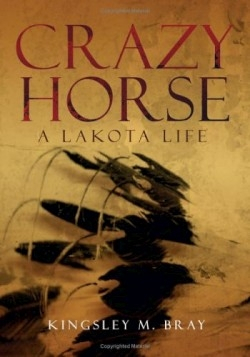Crazy Horse
A Lakota Life
Crazy Horse, an enigmatic Lakota warrior and chief whose life spanned the mid-nineteenth century years of American expansion, has undoubtedly been one of the favorite subjects of Native American biographers during the last sixty years. Each of these has added a layer of mystique to Crazy Horse’s life, starting with Mari Sandoz’s classic 1942 biography, Crazy Horse, the Strange Man of the Oglalas, which this author maintains “helped shift the paradigm in Indian studies, away from the racist stereotyping of the previous century, toward a more empathetic reading of the Lakota world.”
Bray continues in this tradition, drawing on extensive oral histories of Lakota tribal elders, who related episodes in Crazy Horse’s life told to them by their grandparents. Bray interweaves these archival interviews with numerous other primary sources, including Senate hearings, military diaries, U.S. Army records, Indian Agent reports, and annual reports of the U.S. Commissioner of Indian Affairs. The author has also immersed himself in modern Lakota writings, enabling him to place key episodes in Crazy Horse’s life within the context of Lakota traditions and beliefs.
Born in 1840 (approximately), Crazy Horse grew up knowing no other life than the “post-Oregon Trail world, with its inheritance of disease, game attrition, and resource loss.” In his sweat lodge ceremony at age fifteen, Crazy Horse is remembered as asking not for horse herds or battle glories, but “the power to serve his tribe.” Several years later he was invited to join the Strong Hearts, a group of isolationists who shunned contact with Americans, including their handouts of food. Crazy Horse sympathized with these sentiments, although according to contemporary accounts, he strived to avoid political cliques.
The great Lakota council of 1857 was crucial to Crazy Horse’s developing convictions regarding American encroachment. It was here that he first crossed paths with Sitting Bull, who steadfastly maintained that the Black Hills were, and must remain, the heart of Lakota country—a belief shared by Crazy Horse, and one which took him on an unswerving path to the Battle of the Yellowstone and the Great Sioux War, culminating in the Battle of the Little Bighorn in June, 1876.
As a consequence of that battle, the chiefs were forced to sign away title to their beloved Black Hills, and their vast hunting grounds to the west. Crazy Horse gradually loses defectors to his cause, and even his friend Sitting Bull is “pulled toward Canada.” Crazy Horse finally surrenders on May 6, 1877; tribal politics, miscommunications, jealousy, and treachery culminate in his death on September fifth.
The author—not an academic but an English bookseller—has spent twenty years on this project. His comprehensive research has resulted in not only a vivid portrait of this legendary chief, but an enriched understanding of his beleaguered culture, as well.
Reviewed by
Deborah Donovan
Disclosure: This article is not an endorsement, but a review. The publisher of this book provided free copies of the book to have their book reviewed by a professional reviewer. No fee was paid by the publisher for this review. Foreword Reviews only recommends books that we love. Foreword Magazine, Inc. is disclosing this in accordance with the Federal Trade Commission’s 16 CFR, Part 255.

